AI chatbots are changing the rules of online visibility. Instead of being discovered through rankings and clicks as before, reach is also not generated directly within the answers provided by ChatGPT, Gemini or DeepSeek. In this article, we explain what the rise of AI chatbots means for SEO, the risks involved and the opportunities they simultaneously create for marketing and content teams.
- What exactly is an AI chatbot?
- Why this matters for SEO and marketing
- SEO: Rethinking Visibility
- Entity Overview
- Prompts in Detail
- Entity Environment
- What AI Chatbots Can Do for Marketing and SEO
- 1. Faster Content Creation
- 2. Content Personalisation in Marketing
- Internal Efficiency and Knowledge Transfer
- Limits and risks: what AI chatbots cannot do, yet
- Hallucinations and Lack of Factual Accuracy
- Incomplete source citations
- Data Protection and Legal Uncertainties
- Security Vulnerabilities and Potential for Misuse
- Reassessing Visibility
Discover how SISTRIX can be used to improve your search marketing. Use a no-commitment trial with all data and tools: Test SISTRIX for free
AI chatbots are a new addition to traditional web search, but not a complete replacement. For SEO and content professionals, this means the rules of online visibility are shifting thanks to LLMs and AI search engines — and anyone who wants to stay ahead needs to understand how these systems work and how to use them effectively.
What exactly is an AI chatbot?
AI chatbots such as ChatGPT, Gemini or DeepSeek work fundamentally differently from traditional search engines. Instead of presenting a list of results, they generate a direct answer within a dialogue. They are powered by large language models trained on vast amounts of text. Unlike Google or Bing, however, chatbots do not have their own web index. They rely on the linguistic knowledge learned during training and are therefore more dependent on past training data.
This also highlights the difference compared with AI search engines such as Perplexity or Google’s AI Overviews. These systems combine a language model with live search capabilities, allowing them to include up-to-date sources and, in some cases, provide links. Chatbots, on the other hand, rarely use external web searches — and increasingly less so. With ChatGPT, the share has dropped from over 15 per cent to under 2.5 per cent within just a few weeks.

This increases the reliance on static training knowledge, raises the risk of outdated information and means content must be prepared in a way that allows it to be correctly recognised and used even without additional research.
For users, this is convenient – but for website owners, it is problematic. Content is processed, but does not necessarily appear as a visible source. As a result, visibility is created in a new environment that differs clearly from traditional Google search. Whereas rankings and clicks take centre stage there, chatbots depend on whether a brand or topic is defined clearly enough to appear in the model’s answers. But chatbots do not only affect SEO. Alongside the uncertainty surrounding future brand visibility, they also offer advantages for marketing teams: processes can be sped up and simplified. At the same time, they bring other risks – and not just in terms of declining visibility.
Why this matters for SEO and marketing
Chatbots are not just new tools – they are changing user behaviour. Search queries are no longer entered only on Google; they are asked directly in a chat window. And the answer appears immediately, without the need to visit a website. For companies, this means: the click disappears. The information stays within the chat.
Our analysis shows that brands appear relatively rarely in AI chatbot responses so far. In an evaluation of 10 million prompts each, on average only one in three answers contained a brand mention. Brands appeared most often in DeepSeek answers, at 38.5 per cent, followed by Gemini at 33.7 per cent and ChatGPT at 27.2 per cent.
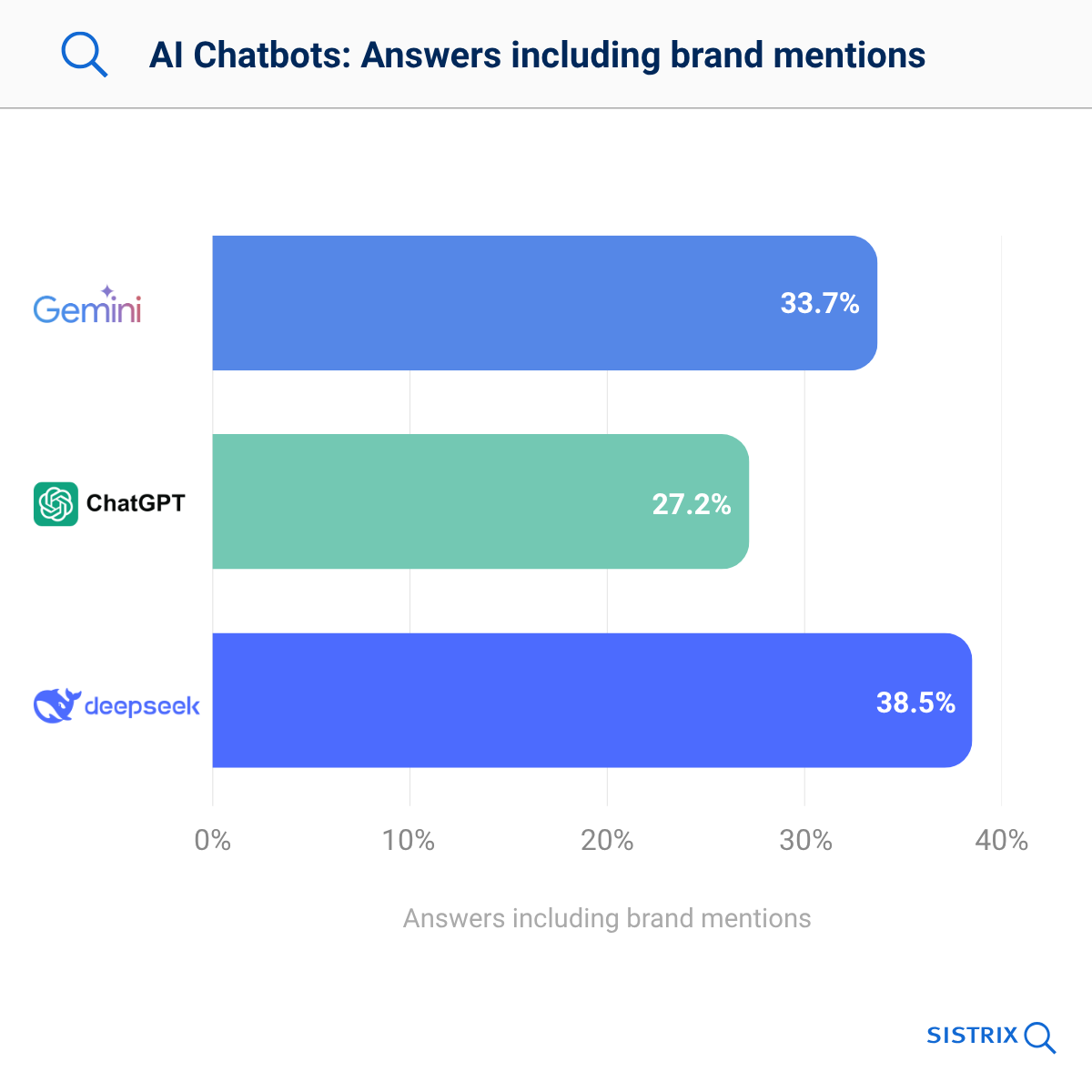
For companies, this means that visibility occurs in only a small proportion of answers – and is therefore highly competitive. Clear entities, consistent content and unambiguous brand references become decisive factors.
This development has direct implications for SEO: those who want to remain visible both in Google search results and in chatbot responses must meet different requirements.
- Precise, structured and machine-readable content: Page content must be clearly organised and technically well prepared so that chatbots can process it without difficulty.
- A trustworthy presence: Content must appear credible, for example through transparent authorship, source references and thematic depth.
- Substance over SEO tricks: It is no longer about fine-tuning technical details but about producing high-quality content with real value.
- Ensuring machine readability: Crawlability, loading times, internal linking and clean structures remain essential.
For many companies, a fundamental question arises: what measurable value do mere citations without clicks actually offer? At present, it is crucial that companies avoid knee-jerk reactions and instead analyse in detail – based on the data – how the new AI chatbots are impacting marketing.
Traditional search engines will remain relevant, but their reach is set to decline significantly. To compensate for these losses, more and better content must be created content that is recognised as a relevant source both in search results and in AI-generated answers. SEO is therefore becoming simultaneously more important and more challenging.
What is clear:
If an AI can answer something flawlessly, no new source is needed. It is therefore not worthwhile to mass-produce texts with ChatGPT that merely rehash already known information. The qualitative demands on SEO and content are rising sharply.
Topics that an AI chatbot can already answer comprehensively and accurately—such as the collective knowledge found on Wikipedia are no longer relevant for SEO. These questions are already being answered without a click or a reference to a source.
SEO: Rethinking Visibility
With AI chatbots, the way visibility is generated online is changing. Instead of relying on a click in Google search, the focus shifts to whether content is recognised by a language model and incorporated into its answers.
To increase the likelihood of being used as a source in AI chatbots and mentioned as a brand, the fundamentals of SEO must be solid, as described above.
But optimisation alone is not enough. It is crucial to understand where your brand appears in chatbot responses and how it is presented. For this purpose, the new SISTRIX features offer valuable insights, including:
Entity Overview
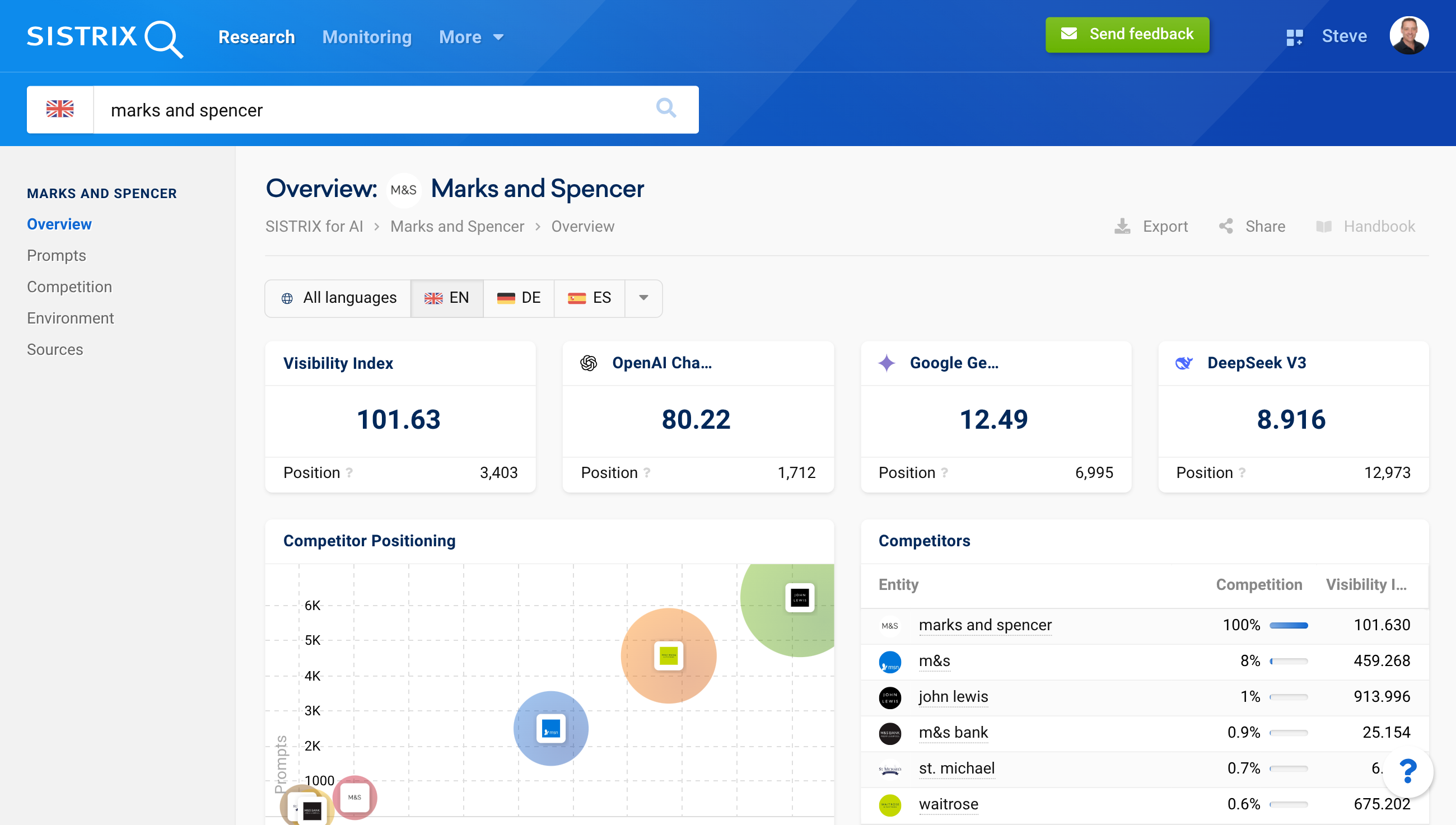
In this overview the baseline situation is shown. The AI Visibility Index shows how prominently a brand is represented in relevant chatbots. The competitor positioning clarifies who dominates the market and where gaps exist. Additionally, the overview lists the most relevant prompts with search volume, competition and ranking – providing a direct insight into the questions where a brand is already present.
Prompts in Detail
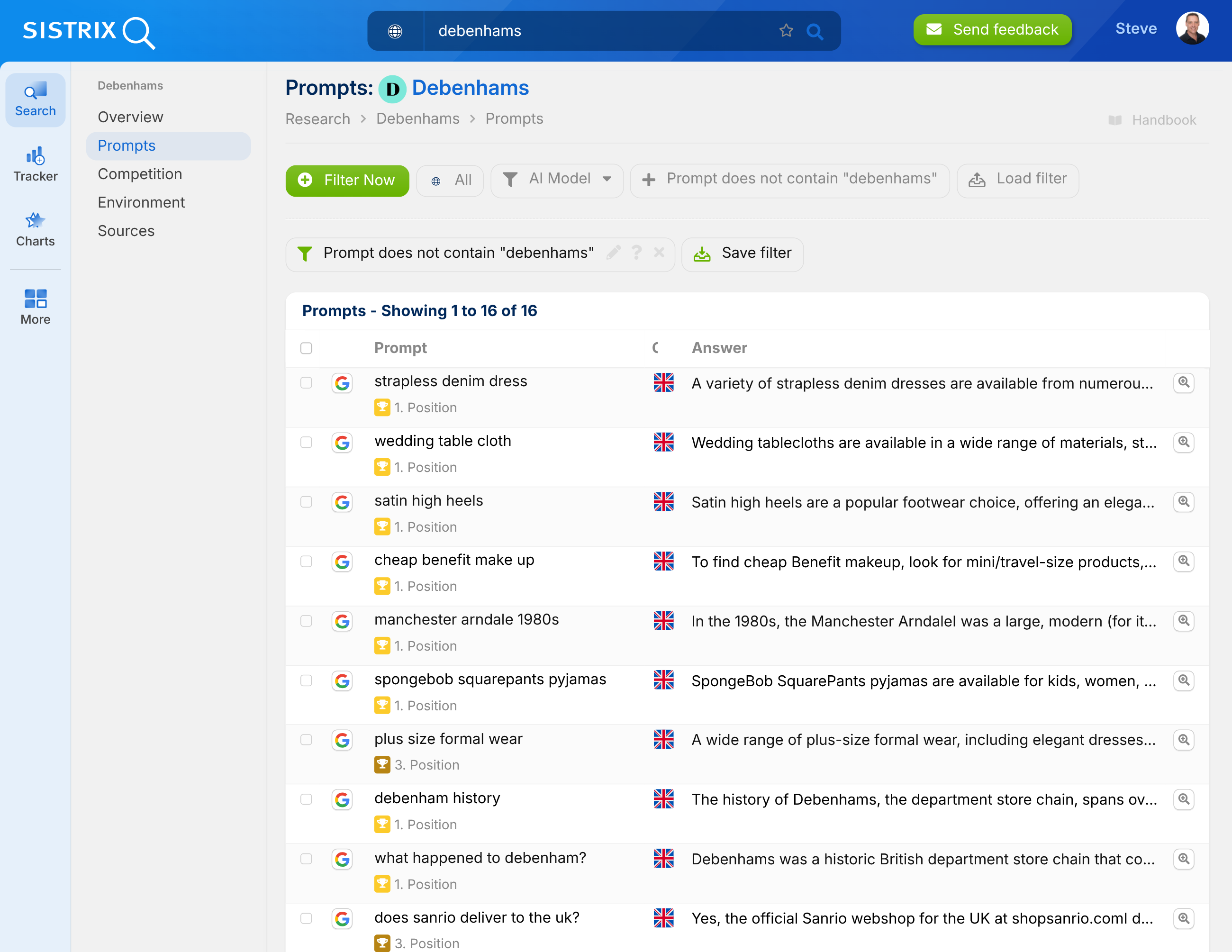
In this view, chatbot responses can be fully traced. You can see which specific questions mention a brand, whether products are described correctly, and where competitors appear preferentially. This enables targeted content optimisation: incorrect information can be corrected, missing topics added, and strengths over competitors strengthened.
Entity Environment
To check whether a brand is visible in its correct context, only appears in generic references, or to see which topics are already covered by competitors, you can view the recognised entity environment for each entity. This shows the thematic contexts in which a brand is mentioned. Related terms and competitors are each displayed with their own visibility index.
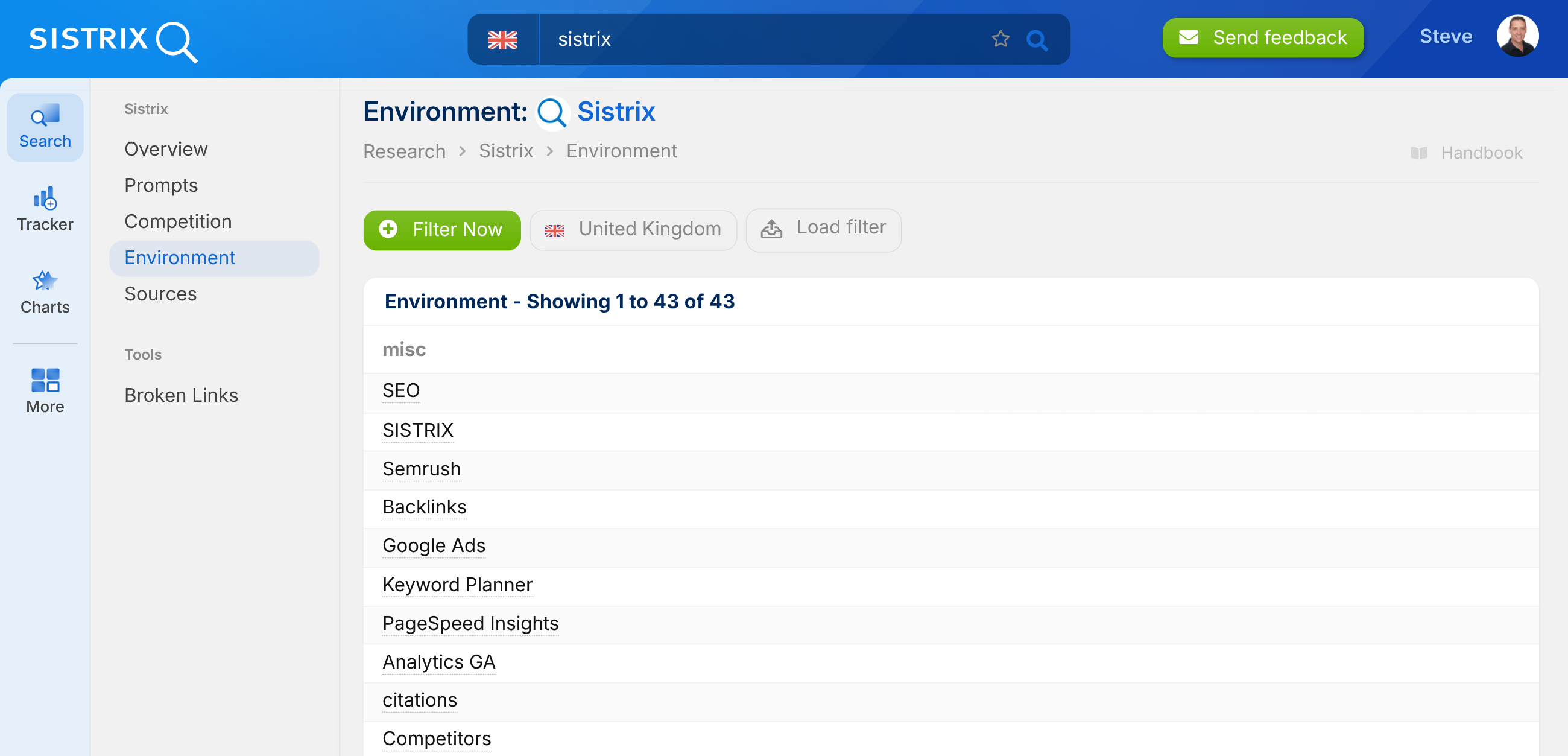
These data make it clear that simply monitoring traditional rankings is no longer enough. Visibility in chatbots is a new channel that requires its own strategies. With SISTRIX, companies can for the first time measure how they appear there and work specifically to strengthen their position.
What AI Chatbots Can Do for Marketing and SEO
AI chatbots are often criticised in the SEO context because they capture clicks and challenge the usual mechanisms of visibility. But beyond these risks, they also offer opportunities. When used correctly, they can relieve marketing teams, speed up processes, and make content more targeted. Those who understand the potential can see chatbots not just as competition, but as a tool for greater efficiency and better results.
1. Faster Content Creation
AI chatbots assist with writing texts, from brainstorming ideas to formulation. They can provide outlines, headings, teasers, FAQs, or full article drafts, which can then be edited by humans or translated into different languages.
For teams with limited resources, this represents a real productivity gain. Chatbots can also act as “sparring partners” in editorial meetings for topic research and structuring. Fully automated text creation, however, remains a significant risk. Moreover, such generic texts offer no added value compared with existing content and are therefore not relevant for search engines.
2. Content Personalisation in Marketing
AI chatbots can analyse user behaviour, identify interests, and suggest personalised content accordingly—whether product recommendations, newsletter copy, or landing pages. When combined with CRM data, even complex conversion paths can be automated.
For campaigns, this means: fewer wasted impressions, more precise targeting, and greater relevance at each touchpoint.
Internal Efficiency and Knowledge Transfer
In larger organisations, chatbots are also used internally: for onboarding support, internal FAQs, translations, or as an interface to databases and tools. This reduces training efforts, improves information flow, and saves considerable time in everyday work.
Limits and risks: what AI chatbots cannot do, yet
Despite all their advances, AI chatbots are not reliable knowledge systems. Their answers are based on patterns and probabilities, not verified sources. This gives rise to specific risks inherent to the underlying technology, which cannot simply be eliminated even with future updates:
Hallucinations and Lack of Factual Accuracy
Chatbots can produce factually incorrect or entirely fabricated content (“hallucinations”), even when expressed with confidence. This is especially problematic in medical, legal, or business-critical contexts. Relying on such content without verification risks not only spreading misinformation but also causing reputational damage.
Incomplete source citations
A central problem is source attribution. Our analysis of 10,000 URLs shows that only a portion of the links cited by chatbots are actually accessible. For Gemini, 42.2% of sources worked directly, with a further 20.7% redirecting. For ChatGPT, it was 35.6%, and for Deepseek 37.8%. Around one third of the links, however, led nowhere. At the same time, many systems do not transparently indicate which sources their answers are based on.
In practice, this means that stable target pages, proper redirects, and clear signals are essential if content is to be reliably incorporated. If sources are missing or lead nowhere, users cannot verify the accuracy of answers, and valuable traffic is lost.

The combination of LLMs with a web index will reduce this problem in the future, but our analyses show that currently around one third of sources are incorrect.
In the beta of our AI chatbot tool, we have therefore integrated the ability to check the accessibility of an entity’s or brand’s sources. All URLs are tested, showing which are reachable and which are not.
By filtering the list to your own domain and displaying only incorrect URLs, the most frequently misattributed sources can be redirected via 301 to the correct content on your website. This way, no visitors are lost who come via ChatGPT and similar services.
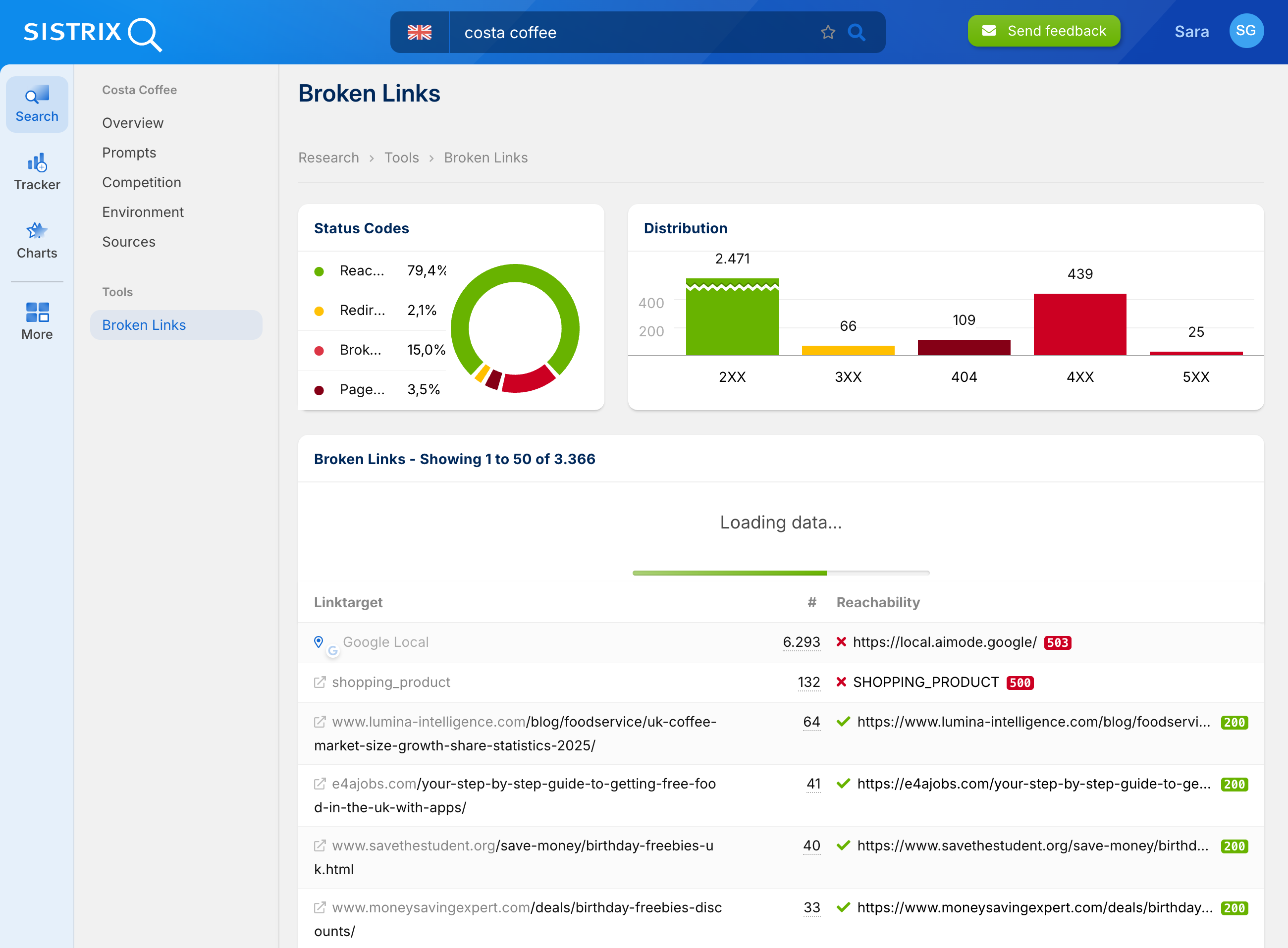
Data Protection and Legal Uncertainties
Inputs into chatbots can be stored and used for training. This is sensitive for companies, particularly when it involves confidential or internal information. Copyrighted content should also neither be entered nor reused without verification.
It also remains unclear who is liable if a chatbot produces incorrect or business-critical statements, or if copyrighted material ends up being used in training. These legal questions have not yet been conclusively resolved and carry risks.
With the EU AI Act, additional obligations arise. Companies must document their use of AI, monitor it, and ensure transparency. Breaches can result in substantial fines.
Security Vulnerabilities and Potential for Misuse
Manipulated inputs and hidden text on websites (so-called prompt injections) can cause a chatbot to output false, harmful, or sensitive content. Publicly accessible systems are particularly at risk, for example in cases of phishing or automated disinformation. Currently, there is no solution to this problem, as it could only be addressed by significantly restricting the technology to specific use cases and closed environments.
Reassessing Visibility
With the rise of AI chatbots, the logic of online visibility is shifting. Content is no longer just displayed in traditional search results but is instead directly incorporated into responses. For businesses, this means that clicks are becoming less frequent, and brand presence is emerging in a new environment.
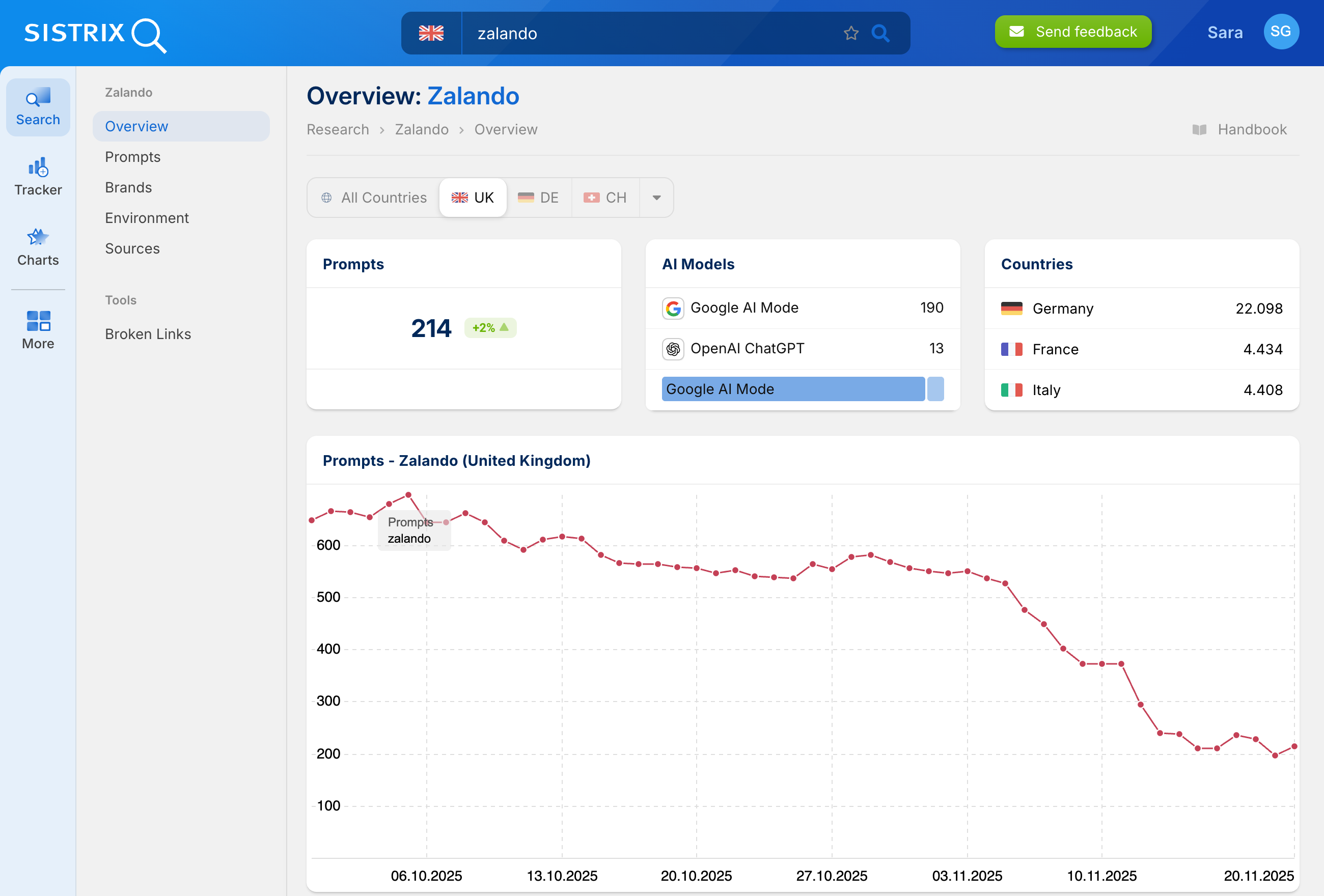
Those who want to remain relevant must understand which content is picked up by language models, how their brand is represented, and which competitors are already visible. Visibility thus becomes more measurable, but also more complex. Only those who consistently work on precision, trustworthiness, and machine-readable structure—and regularly review their own position—can strategically seize opportunities in this new channel.
Test SISTRIX for Free
- Free 14-day test account
- Non-binding. No termination necessary
- Personalised on-boarding with experts